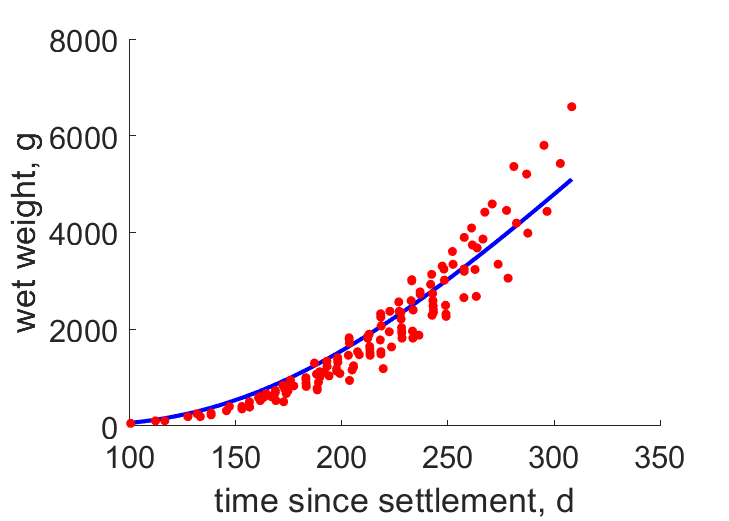Predictions & Data for this entry
| Model: abj | climate: MA | migrate: | phylum: |
| COMPLETE = 2.5 | ecozone: MI, MPSW | food: bjPz, jiCi, jiCvf | class: |
| MRE = 0.151 | habitat: 0jMc, jiMr | gender: D | order: |
| SMSE = 0.040 | embryo: Mc | reprod: Os | family: |
Zero-variate data
| Data | Observed | Predicted | (RE) | Unit | Description | Reference |
|---|---|---|---|---|---|---|
| ab_25 | 25 | 27.24 | (0.08945) | d | age at birth | Heuk1976 |
| ab_13 | 125 | 111.2 | (0.1106) | d | age at birth | Heuk1976 |
| ts | 32.5 | 48.43 | (0.4901) | d | time since birth at settlement | Heuk1976 |
| tp | 210 | 196.9 | (0.06261) | d | time since birth at puberty | HerwDepz2012 |
| am | 320.2 | 338.6 | (0.05718) | d | life span | Heuk1976 |
| Lb | 0.3 | 0.2968 | (0.01074) | cm | mantle length at birth | Heuk1976 |
| Wwb | 0.0055 | 0.003749 | (0.3183) | g | wet weight at birth | guess |
| Wws | 0.3 | 0.2803 | (0.06571) | g | wet weight at settlement | Heuk1976 |
| Wwp | 1000 | 983.5 | (0.01645) | g | wet weight at puberty | Heuk1976 |
| Wwi | 3600 | 5179 | (0.4386) | g | ultimate wet weight | Heuk1976 |
| Ni | 7e+05 | 4.431e+05 | (0.367) | # | cum reprod at death | Heuk1976 |
Uni- and bivariate data
| Data | Figure | Independent variable | Dependent variable | (RE) | Reference |
|---|---|---|---|---|---|
| tW |  | time since settlement | wet weight | (0.2002) | Heuk1976 |
Pseudo-data at Tref = 20°C
| Data | Generalised animal | Octopus cyanea | Unit | Description |
|---|---|---|---|---|
| v | 0.02 | 0.001762 | cm/d | energy conductance |
| p_M | 18 | 2515 | J/d.cm^3 | vol-spec som maint |
| k_J | 0.002 | 0.002 | 1/d | maturity maint rate coefficient |
| k | 0.3 | 0.00438 | - | maintenance ratio |
| kap | 0.8 | 0.4472 | - | allocation fraction to soma |
| kap_G | 0.8 | 0.7977 | - | growth efficiency |
| kap_R | 0.95 | 0.95 | - | reproduction efficiency |
Discussion
- z is not well-fixed by data, size ultimate size is much larger than size at death
- in view of fitting results, puberty does not coincide with mating and part of structure converts to eggs just before death
- model abj has been used, meaning that settlement has no effect on acceleration
Facts
- semelparous: death at first spawning, 10 d after last hatch (Ref: Wiki)
- Digestion efficiency independent of feeding rate (Ref: Heuk1976)
- small eggs with a planktontic larval stage, difficult to culture (Ref: Heuk1976)
- hatches using a hatching gland (Hoyles organ) (Ref: Heuk1976)
- males and females grow at the same rate (Ref: Heuk1976)
Bibliography